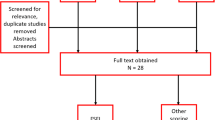Abstract
Purpose
To assess sexual function (SF) and quality of life (QOL) in women with polycystic ovary syndrome (PCOS).
Methods
A cross-sectional study was conducted to assess 56 women with PCOS and 102 control women with regular menstrual cycles. To assess SF and QOL in Brazilian women with PCOS with Female Sexual Function Index (FSFI) and the WHOQOL-bref questionnaires.
Results
Women with PCOS had a worse evaluation to arousal, lubrication, satisfaction, pain and total FSFI, and there was no difference in sexual desire and orgasm. Besides, they had a worse evaluation concerning health status than controls. The body mass index was inversely correlated to the QOL, especially to the physical, psychological, environment aspects and self-assessment of QOL, but it did not show correlation to the SF.
Conclusion
Women with PCOS had a worse sexual function and self-assessment of health condition in comparison to controls. The body weight as isolated symptom was correlated to the worsening in quality of life, but not with the worsening of sexual function.
Similar content being viewed by others
References
Rotterdam ESHRE/ASRM-sponsored PCOS consensus workshop group (2004) Revised 2003 consensus on diagnostic criteria and long term health risks related to polycystic ovary syndrome. Fertil Steril 81:19–25
Fauser BC, Tarlatzis BC, Rebar RW, Legro RS, Balen AH, Lobo R et al (2012) Consensus on women’s health aspects of polycystic ovary syndrome (PCOS) the Amsterdam ESHERE/ASRM-Sponsored 3rd POCS Workshop Group. Fertil Steril 97:28–38
Salley KE, Wickham EP, Cheang KI, Essah PA, Karjane NW, Nestler JE (2007) Glucose intolerance in polycystic ovary syndrome—a position statement of the Androgen Excess Society. J Clin Endocrinol Metab 92:4546–4556
Amsterdam ESHRE/ASRM-Sponsored 3rd PCOS Consensus Workshop Group (2012) Consensus on women’s health aspects of polycystic ovary syndrome (PCOS). Hum Reprod 27:14–24
Niet JE, Koning CM, Pastoor H, Duivevvoorden HJ, Valkenburg O, Ramakers MJ et al (2010) Psychological well-being and sexarche in women with polycystic ovary syndrome. Hum Reprod 25:1497–1503
McCook Reame NE, Thatcher SS (2005) Health related quality of life issues in women with polycystic ovary syndrome. J Obstet Gynecol Neonatal Nurs 34:12–20
Jones GL, Hale JM, Balen AH, Ledger WL (2008) Health-related quality of life measurement in women with polycystic ovary syndrome: a systematic review. Hum Reprod Update 14:15–25
Barth JH, Catalan J, Cherry CA, Day A (1993) Psychological morbidity in women referred for treatment of hirsutism. J Psychosom Res 37:615–619
Mallon E, Newton JN, Klassen A, Stewart-Brown SL, Ryan TJ, Finlay AY (1999) The quality of life in acne: a comparison with general medical conditions using generic questionnaires. Br J Dermatol 140:672–676
Downey J, Yingling S, McKinney M, Husami N, Jewelewicz R, Maidman J (1989) Mood disorders, psychiatric symptoms, and distress in women presenting for infertility evaluation. Fertil Steril 52:425–432
Kocelak P, Chudek J, Naworska B, Sosnowska K, Kotlarz B, Mazurek M et al (2012) Psychological disturbances and quality of life in obese and infertile women and men. Int J Endocrinol 5:1–14
Malik-Aslam A, Reaney MD, Speight J (2010) The suitability of polycystic ovary syndrome-specific questionnaires for measuring the impact of PCOS on quality of life in clinical trials. Value Health 13:440–446
Thomson RL, Buckey JD, Lim SS, Noakes M, Clifton PM, Norman RJ et al (2010) Lifestyle management improves quality of life and depression in overweight and obese women with polycystic ovary syndrome. Fertil Steril 94:1812–1816
Ercan CM, Coksuer H, Aydogan U, Alanbay I, Keskin U, Karasahin KE et al (2013) Sexual dysfunction assessment and hormonal correlations in patients with polycystic ovary syndrome. Int J Impot Res 25:127–132
Stovall DW, Scriver JL, Clayton AH, Williams CD, Pastore LM (2012) Sexual function in women with polycystic ovary syndrome. J Sex Med 9:224–230
Ferriman D, Gallwey JD (1961) Clinical assessment of body hair growth in women. J Clin Endocrinol Metab 21:1440–1447
Rosen R, Brown C, Heiman J, Leiblum S, Meston C, Shabsigh R et al (2000) The Female Sexual Function Index (FSFI): a multidimensional self-report instrument for the assessment of female sexual function. J Sex Marital Ther 26:191–208
Meston CM, Derogatis LR (2002) Validated instruments for assessing female sexual function. J Sex Marital Ther 28:155–164
Fleck MPA, Louzada S, Xavier M, Chachamovich E, Vieira G, Santos L et al (2000) Aplicação da versão em português do instrumento abreviado de avaliação da qualidade de vida “WHOQOL-bref”. Rev Saúde Publica 34:178–183
The WHOQOL Group (1994) Development of the World Health Organization quality of life assessment instrument (the WHOQOL). In: Orley J, Kuyken W (eds) Quality of life assessment: international perspectives. Springer, Heidelberg, pp 41–69
Tan S, Hahn S, Benson S, Janssen OE, Dietz T, Kimmig R et al (2008) Psycological implications of infertility in women with polycystic ovary syndrome. Human Reprod 23:2064–2071
Elsembruch S, Hahn S, Kowalsky D, Offner H, Schedlowski M, Mann K, Janssen OE (2003) Quality of life, psychosocial well-being, and sexual satisfaction in women with polycystic ovary syndrome. J Clin Endocrinol Metab 88:5801–5807
Hahn S, Janssen OE, Tan S, Pleger K, Mann K, Schedlowski M, Kimmig R, Benson S et al (2005) Clinical and psychological correlates of quality of life in polycystic ovary syndrome. Eur J Endocrinol 153:853–860
Mansson M, Norstro¨m K, Holte J, Landin-Wilhelmsen K, Dahlgren E, Lande´n M (2011) Sexuality and psychological wellbeing in women with polycystic ovary syndrome compared with healthy controls. Eur J Obstet Gynecol Reprod Biol 155:161
Drosdzol A, Skrzypulec V, Mazur B, Pawlińska-Chmara R (2007) Quality of life and marital sexual satisfaction in women with polycystic ovary syndrome. Folia Histochem Cytobiol 45:S93–S97
Kaneshiro B, Jensen JT, Carlson NE, Harvey SM, Nichols MD, Edelman AB (2008) Body mass index and sexual behavior. Obstet Gynecol 112:586–592
Conflict of interest
None.
Author information
Authors and Affiliations
Corresponding author
Rights and permissions
About this article
Cite this article
Benetti-Pinto, C.L., Ferreira, S.R., Antunes, A. et al. The influence of body weight on sexual function and quality of life in women with polycystic ovary syndrome. Arch Gynecol Obstet 291, 451–455 (2015). https://doi.org/10.1007/s00404-014-3423-1
Received:
Accepted:
Published:
Issue Date:
DOI: https://doi.org/10.1007/s00404-014-3423-1




